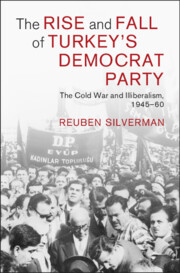Refine search
Actions for selected content:
597 results
Chapter 16 - Politics
- from Part III - Cultural and Intellectual Worlds
-
-
- Book:
- Fanny Hensel and Felix Mendelssohn in Context
- Published online:
- 19 December 2025
- Print publication:
- 08 January 2026, pp 126-132
-
- Chapter
- Export citation
Judith Shklar’s Ethos of Skeptical Vigilance
-
- Journal:
- The Review of Politics , First View
- Published online by Cambridge University Press:
- 19 December 2025, pp. 1-22
-
- Article
-
- You have access
- Open access
- HTML
- Export citation

Invisible Fatherland
- Constitutional Patriotism in Weimar Germany
-
- Published online:
- 18 December 2025
- Print publication:
- 22 January 2026
Cassirer and Left-Kantianism
-
- Journal:
- Kantian Review , First View
- Published online by Cambridge University Press:
- 11 December 2025, pp. 1-24
-
- Article
-
- You have access
- Open access
- HTML
- Export citation
IS CONTRACT LAW LIBERAL? ON AUTONOMY AND EXCHANGE
-
- Journal:
- The Cambridge Law Journal , First View
- Published online by Cambridge University Press:
- 11 December 2025, pp. 1-32
-
- Article
-
- You have access
- Open access
- HTML
- Export citation
1 - Little Debts
-
- Book:
- Debts Unpaid
- Published online:
- 04 November 2025
- Print publication:
- 20 November 2025, pp 20-52
-
- Chapter
- Export citation
10 - Munich 1938
- from Part III - The Twentieth Century through World War II
-
- Book:
- Crises, War, and Diplomacy
- Published online:
- 07 November 2025
- Print publication:
- 20 November 2025, pp 187-209
-
- Chapter
- Export citation

Moral Autopsy
- Truths, Secrets, and the Judicial Afterlives of Communist Secret Service Archives
-
- Published online:
- 18 November 2025
- Print publication:
- 30 October 2025
Case 3.2 - You Got What?
- from Part III - Case Studies in Mezzo-Level Practice
-
-
- Book:
- Critical Race Theory in Action
- Published online:
- 25 October 2025
- Print publication:
- 13 November 2025, pp 70-80
-
- Chapter
- Export citation
A Double-Edged Sword: Excommunication in Nineteenth-Century French Canada
-
- Journal:
- Church History , First View
- Published online by Cambridge University Press:
- 13 November 2025, pp. 1-42
-
- Article
-
- You have access
- Open access
- HTML
- Export citation
2 - Children of the Revolution: Defining the Democrat Party, 1946–1950
-
- Book:
- The Rise and Fall of Turkey's Democrat Party
- Published online:
- 23 October 2025
- Print publication:
- 06 November 2025, pp 61-98
-
- Chapter
- Export citation
Conclusion - Of Truth and Political Responsibility
-
- Book:
- Moral Autopsy
- Published online:
- 18 November 2025
- Print publication:
- 30 October 2025, pp 238-264
-
- Chapter
- Export citation
3 - Liberalism(s) and International Security
- from Part I - Security in Theory
-
- Book:
- Understanding International Security
- Published online:
- 11 October 2025
- Print publication:
- 30 October 2025, pp 40-59
-
- Chapter
- Export citation
Veiling in rural Bangladesh: women’s rights consciousness, choice, and subjectivity
-
- Journal:
- Politics and Religion , First View
- Published online by Cambridge University Press:
- 24 October 2025, pp. 1-19
-
- Article
-
- You have access
- Open access
- HTML
- Export citation

The Rise and Fall of Turkey's Democrat Party
- The Cold War and Illiberalism, 1945–60
-
- Published online:
- 23 October 2025
- Print publication:
- 06 November 2025
2 - Overpopulation Discourse and the Post-1945 Order
-
- Book:
- Population Control as a Human Right
- Published online:
- 09 October 2025
- Print publication:
- 23 October 2025, pp 17-31
-
- Chapter
- Export citation
Too Woke or Not Woke Enough? Racial Awareness in the Church of England
-
- Journal:
- Journal of Anglican Studies , First View
- Published online by Cambridge University Press:
- 20 October 2025, pp. 1-23
-
- Article
-
- You have access
- Open access
- HTML
- Export citation
Chapter 1 - Hegel and Liberalism
- from Part I - Hegel, Freedom and Liberalism
-
- Book:
- Hegel Beyond Liberalism
- Published online:
- 27 September 2025
- Print publication:
- 16 October 2025, pp 13-36
-
- Chapter
- Export citation
Introduction
-
- Book:
- Hegel Beyond Liberalism
- Published online:
- 27 September 2025
- Print publication:
- 16 October 2025, pp 1-10
-
- Chapter
-
- You have access
- HTML
- Export citation
Conclusion: Beyond Hegel
-
- Book:
- Hegel Beyond Liberalism
- Published online:
- 27 September 2025
- Print publication:
- 16 October 2025, pp 207-213
-
- Chapter
- Export citation
